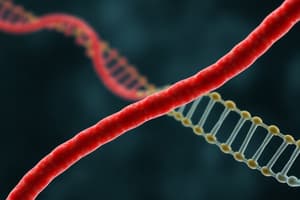Podcast
Questions and Answers
What does RNA contain instead of Thymine?
What does RNA contain instead of Thymine?
- Cytosine
- Guanine
- Uracil (correct)
- Adenine
In transcription, both strands of DNA are copied into RNA.
In transcription, both strands of DNA are copied into RNA.
False (B)
Name the three stages of transcription.
Name the three stages of transcription.
Initiation, Elongation, Termination
The process by which genetic information flows from DNA to mRNA is called __________.
The process by which genetic information flows from DNA to mRNA is called __________.
Match the following components to their functions in transcription:
Match the following components to their functions in transcription:
What is the purpose of the 5’ cap added to mRNA?
What is the purpose of the 5’ cap added to mRNA?
The Poly-A-Tail is added to the 5’ end of the mRNA transcript.
The Poly-A-Tail is added to the 5’ end of the mRNA transcript.
What is the process by which introns are removed from the primary RNA transcript called?
What is the process by which introns are removed from the primary RNA transcript called?
The enzyme that adds adenine nucleotides to the 3’ end of pre-mRNA is called __________.
The enzyme that adds adenine nucleotides to the 3’ end of pre-mRNA is called __________.
Match the following terms with their definitions:
Match the following terms with their definitions:
What role do spliceosomes play during pre-mRNA processing?
What role do spliceosomes play during pre-mRNA processing?
All mRNA transcripts are edited after they are transcribed.
All mRNA transcripts are edited after they are transcribed.
What is the typical range of adenine nucleotides added by Poly A Polymerase to form the Poly-A-Tail?
What is the typical range of adenine nucleotides added by Poly A Polymerase to form the Poly-A-Tail?
What is the primary role of the σ-subunit in prokaryotic transcription?
What is the primary role of the σ-subunit in prokaryotic transcription?
In eukaryotes, RNA polymerase can bind to the DNA template on its own.
In eukaryotes, RNA polymerase can bind to the DNA template on its own.
What sequence signals the termination of transcription in prokaryotes?
What sequence signals the termination of transcription in prokaryotes?
In eukaryotes, the RNA polymerase II binds to the promoter after transcription factors have ______.
In eukaryotes, the RNA polymerase II binds to the promoter after transcription factors have ______.
Match the following components of transcription with their roles:
Match the following components of transcription with their roles:
What is the direction of RNA synthesis during transcription?
What is the direction of RNA synthesis during transcription?
In prokaryotes, mRNA requires further modification after transcription before it translates into proteins.
In prokaryotes, mRNA requires further modification after transcription before it translates into proteins.
What must happen to pre-mRNA in eukaryotic cells before it can be translated?
What must happen to pre-mRNA in eukaryotic cells before it can be translated?
The two consensus sequences found upstream of the start point in prokaryotic transcription are located at the -10 and -______ regions.
The two consensus sequences found upstream of the start point in prokaryotic transcription are located at the -10 and -______ regions.
What component do bacteria lack that separates transcription from translation?
What component do bacteria lack that separates transcription from translation?
Flashcards are hidden until you start studying
Study Notes
Gene Expression - Transcription
- The central dogma is the process of genetic information flow from DNA to mRNA to proteins, occurring in two stages: transcription and translation.
- Transcription is the synthesis of mRNA using genetic information encoded in DNA, where a DNA strand serves as a template for mRNA synthesis.
- RNA contains uracil instead of thymine, which is present in DNA.
- Only one strand of the double-stranded DNA is copied into RNA, known as the template strand.
- Transcription in prokaryotes and eukaryotes involves three stages: initiation, elongation, and termination.
Transcription in Prokaryotes
- The promoter is a DNA sequence where RNA polymerase attaches and initiates transcription, containing two sequences: a start point and the region where synthesis begins.
- RNA polymerase separates the two DNA strands and joins complementary RNA nucleotides to the DNA template strand.
- The prokaryotic RNA polymerase comprises five polypeptide subunits: β, β', α, α, and σ.
- The holoenzyme is the enzyme containing all five subunits.
- The σ-subunit is involved in transcription initiation and causes the polymerase to synthesize mRNA from a specific initiation site.
- The -10 and -35 regions upstream of the start point contain two promoter consensus sequences, recognized by the σ-subunit.
- Once transcription is initiated, the σ-subunit detaches from the polymerase.
Transcription in Eukaryotes
- Eukaryotic RNA polymerase requires transcription factors to bind to the promoter region and recruit the polymerase.
- The TATA box and transcription start point are crucial for forming the initiation transcription complex in the promoter region.
- Transcription factors bind to DNA, allowing RNA polymerase II to attach and initiate transcription.
- RNA polymerase separates DNA strands and begins RNA synthesis.
Pre-mRNA Processing in Eukaryotes
- Pre-mRNA processing in eukaryotes occurs before the RNA transcript can leave the nucleus, transforming it into final mRNA ready for translation.
- Pre-mRNA processing involves three steps: addition of stabilizing and signaling factors, removal of introns, and mRNA editing.
- The 5' capping involves adding a 7-methylguanosine cap to the 5' end of the pre-mRNA, protecting it from degradation and initiating translation.
- The 3' poly-A tail involves adding a sequence of adenine nucleotides to the 3' end, protecting the pre-mRNA from degradation and facilitating its export to the cytoplasm.
- Introns are non-coding sequences removed during RNA processing, whereas exons are coding sequences that remain in the final mRNA.
- Spliceosomes recognize the 5' and 3' ends of introns to remove them, and small RNAs within the spliceosome pair with intron nucleotides.
- RNA splicing involves cutting out introns, joining exons, and altering the 5' and 3' ends of pre-mRNA.
Studying That Suits You
Use AI to generate personalized quizzes and flashcards to suit your learning preferences.




